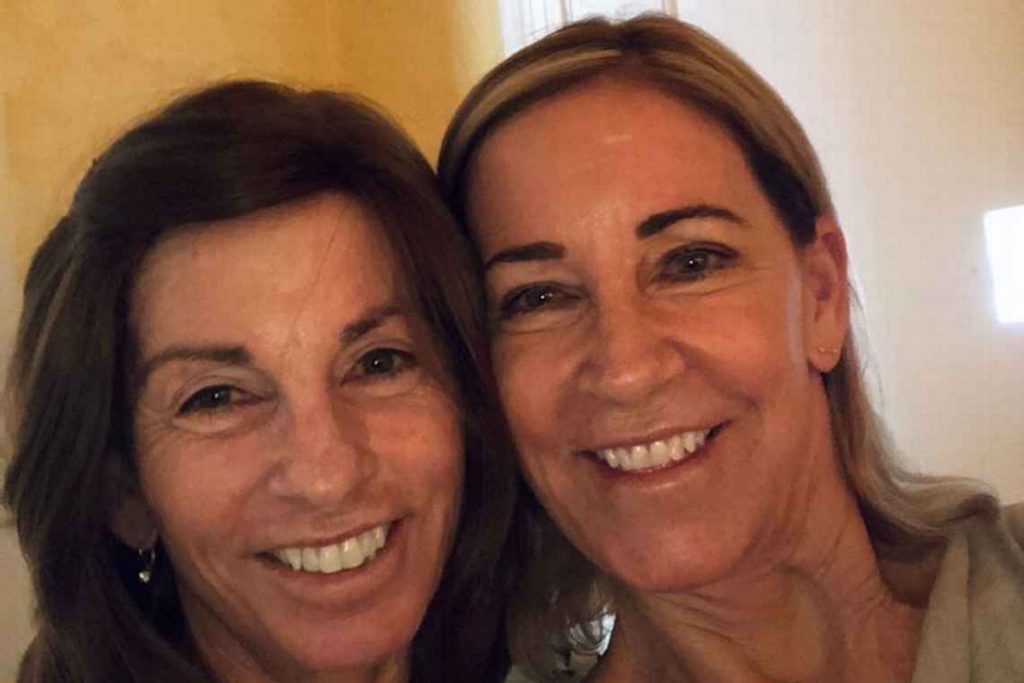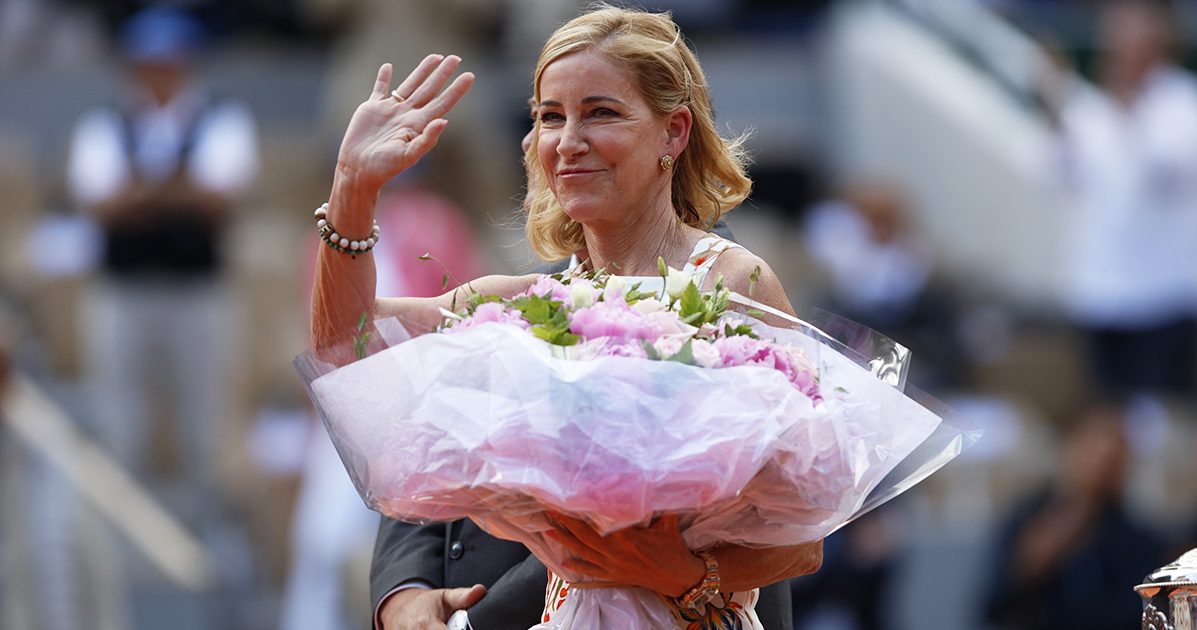Celebrating the Halfway Point
- Tennis legend Chris Evert, 67, is officially halfway done with chemotherapy to treat her stage 1 ovarian cancer.
- Evert shared the news of her ovarian cancer diagnosis in an ESPN article published earlier this year. Her diagnosis and what it took to get there was described in vivid detail, including when she learned she had the same gene mutation BRCA1 that caused her sister’s ovarian cancer.
- Doctors have two main approaches to treatment when they are working with ovarian cancer patients, and both methods offer patients a combination of chemotherapy and surgery, according to SurvivorNet experts.
Evert, 67, posted a video of herself at the hospital while getting her third infusion, which she says marks the halfway point.
Read MoreUpdate!â¤ï¸ðŸ‘ðŸ‘🙠pic.twitter.com/ZtSaJp4K2Y
Chris Evert (@ChrissieEvert) February 28, 2022
In the video, Evert's ex-husband Andy Mill was again by her side during the five-hour infusion. (He also accompanied her to her first-ever infusion.)
"This is my caregiver who came to bring me today Andy, ever the most generous and gracious ex-husband," Evert said. "And he is part of my support group, as is Claire, my sister, who flies down for three days every time I have chemo. And Alex, my son, who lives with me during the chemo because I have to have somebody living with me."
"I've got a great support group," she added.
Chris Evert's Cancer Diagnosis
Chris Evert shared the news of her ovarian cancer diagnosis in an ESPN article published earlier this year. Her diagnosis and what it took to get there was described in vivid detail.
Her story is unfortunately not an uncommon one, but it has a more positive outcome than most ovarian cancer patients because the disease is often caught too late. In Evert's case, she is just stage 1.

When speaking about Evert's case specifically, world-renowned gynecological oncologist Dr. Beth Karlan of UCLA Health told SurvivorNet, "when she found out, at age 67, that her sister had this mutation (BRCA1), she got tested, found she had it too, acted on it, had the prophylactic surgery, and serendipitously was found to have a very early and likely curable ovarian cancer."
However, that was not the case for Evert's younger sister, Jeanne Evert Dubin, who was also a professional tennis player. Dubin died from advanced-stage ovarian cancer in February 2020. She was 62 years old.
When Dubin was diagnosed with cancer, it was in its later stage, and it had spread. That is often the case with ovarian cancer, many SurvivorNet experts have told us. Ovarian cancer is almost impossible to diagnose early like in Evert's case because women do not begin to show symptoms until the disease has reached its later stage. There are also no routine screening tests recommended for women who are at an average risk for ovarian cancer.
How did Evert catch her ovarian cancer so early? She found out she had the BRCA1 gene mutation and began to get regular cancer screenings.
The BRCA1 (BReast CAncer 1) or BRCA2 (BReast CAncer 2) genes help cells repair their DNA damage. Having a change, or mutation, in one of these genes increases a woman's risk of developing ovarian and breast cancer. These gene mutations are commonly passed down in families; if a parent carries a BRCA gene mutation, there is a 50-50 chance you could be carrying it as well.
When Dubin, Chris Evert's sister, was going through cancer treatment, she had tested negative for the BRCA1 gene. Because of this, her family members, including Evert, were not encouraged to seek genetic testing themselves.
However, it was later proven that Dubin did in fact have the pathogenic BRCA1 gene, which increased her chances of developing ovarian cancer. This prompted Evert to "immediately" send her blood in for genetic testing, which revealed she also had the pathogenic variant of the BRCA1 gene. (Gene mutations can either be benign or pathogenic.)
Due to her increased risk of developing ovarian cancer, Evert decided in collaboration with her doctor to have a hysterectomy, which is a surgical procedure to remove the uterus. She had this procedure done first as her sister died from a type of gynecological cancer, but a mastectomy surgery that removes the entire breast was planned for later down the line as BRCA1 can also increase a woman's chances of developing breast cancer.
But a proactive measure Evert's hysterectomy turned out to be a necessary step in her own cancer journey, as pathology following surgery revealed malignant cells and a tumor originating in Evert's left fallopian tube.
Ovarian Cancer Treatment: Chemotherapy & Surgery
Doctors have two main approaches to treatment when they are working with ovarian cancer patients, and both methods offer patients a combination of chemotherapy and surgery, according to Dr. Jose Alejandro Rauh-Hain, a gynecologic oncologist at MD Anderson Cancer Center.
"Both groups (of women) get chemotherapy and surgery," he explained during a previous interview with SurvivorNet, "it's just the sequence of how we do it."
Ovarian Cancer Treatment: Surgery or Chemotherapy First?
If a doctor is confident they can remove the ovarian tumor completely without initial cycles of chemotherapy, the doctor will go ahead with a surgical procedure. Chris Evert's case was unique in that her cancer was discovered after she had preventative surgery, so the surgery part of treatment has already been taken care of.
The group that receives surgery first still goes through chemotherapy, like Evert is going through now, following the operation to ensure that the cancerous tissue is fully excised. This process is known as adjuvant chemotherapy, or a therapy given after initial treatment to ensure effectiveness.
Evert explained in her video that the chemotherapy infusions take about five hours.
“(The) first week I don’t feel great. I have nausea and I have, like, electric shocks on my body, but the second third week, I feel pretty good,” she said. “And then as soon as I feel pretty good, I have to have another one, but it’s worth it.”
The other group is made up of women whom doctors are not confident they can perform successful surgical tumor removal. This group receives chemotherapy before surgery; this group usually receives a final chemotherapeutic treatment after surgery as further assurance that the cancerous tissue is gone.
This necessary combination of both treatments is related in part to the particular virulence of ovarian tumors. The cancer is particularly difficult to detect, so the average woman has a sizable tumor once she is diagnosed. Because of this, both chemotherapy and surgery are needed to remove the cancer.
Contributing: SurvivorNet staff reports
Learn more about SurvivorNet's rigorous medical review process.


